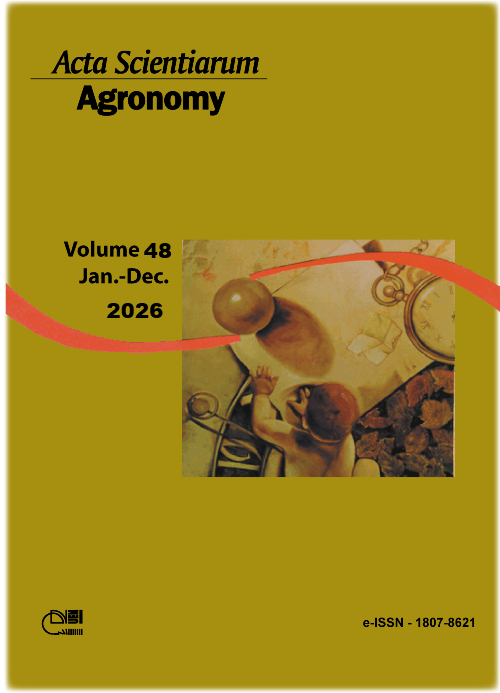Inference of leaf nitrogen concentration using machine learning on data resampled to the spectral resolution of Sentinel-2
Abstract
Nitrogen (N) is among the main nutrients widely used in agriculture worldwide; however, its administration and management can be challenging. Excess nitrogen is harmful to plant health and the environment, requiring effective monitoring of leaf nitrogen concentration (LNC) in field crops. Remote sensing stands out as a valuable tool in this context. This study contributed to the monitoring of LNC by implementing a machine learning algorithm based on the processing of reflectance data from Sentinel-2 (S2) satellites obtained via spectral resampling. For this purpose, five independent datasets containing leaf reflectance measurements collected by spectroradiometers were resampled to the spectral resolution of the sensors onboard the S2 satellites. LNC prediction models were developed from the resampled datasets, using Support Vector Regression (SVR) and Random Forest Regression (RFR), with 75% of the data from each set used to train a model and the remaining 25% for validation. The models demonstrated good predictive power, with the Root Mean Squared Error (RMSE) ranging from 0.39 to 0.94%. Furthermore, this study investigated the transferability of the models' predictive power by using 100% of the data from each set for training and validating predictions on the other sets. To improve transferability, the Transfer Component Analysis (TCA) technique was applied to adapt domains between the sets. This analysis revealed favorable results, especially with the TCA-SVR and TCA-RFR combinations, highlighting a greater capacity to extract transferable spectral features between different leaf reflectance datasets. It was concluded that spectral resampling does not hinder the development of effective LNC prediction models. Aligning this resampling with the resolution of Sentinel-2 sensors, resulted in more efficient monitoring of LNC, eliminating the need to individually reference each sampling point. This approach simplified the monitoring process, reduced both time and costs, and was directly beneficial to producers.
Downloads
References
Berger, K., Verrelst, J., Féret, J.-B., Wang, Z., Wocher, M., Strathmann, M., Danner, M., Mauser, W., & Hank, T. (2020a). Crop nitrogen monitoring: Recent progress and principal developments in the context of imaging spectroscopy missions. Remote Sensing of Environment, 242, 111758. https://doi.org/10.1016/j.rse.2020.111758
Berger, K., Verrelst, J., Féret, J.-B., Hank, T., Wocher, M., Mauser, W., & Camps-Valls, G. (2020b). Retrieval of aboveground crop nitrogen content with a hybrid machine learning method. International Journal of Applied Earth Observation and Geoinformation, 92(2020), 1-15. https://doi.org/10.1016/j.jag.2020.102174
Cilia, C., Panigada C., Rossini, M., Meroni, M., Busetto, L., Amaducci, S., Boschetti, M., Picchi, V., & Colombo, R. (2014). Nitrogen status assessment for variable rate fertilization in maize through hyperspectral imagery. Remote Sensing, 6(7), 6549-6565. https://doi.org/10.3390/rs6076549
Clevers, J. G. P. W., & Kooistra, L. (2011). Using hyperspectral remote sensing data for retrieving canopy chlorophyll and nitrogen content. IEEE Journal of Selected Topics in Applied Earth Observations and Remote Sensing, 5(2), 574-583. https://doi.org/10.1109/JSTARS.2011.2176468
Drucker, H., Burges, C. J. C., Kaufman, L., Smola, A., & Vapnik, V. (1996). Support vector regression machines. Advances in Neural Information Processing Systems, 9, 155-161. https://papers.nips.cc/paper_files/paper/1996/file/d38901788c533e8286cb6400b40b386d-Paper.pdf
European Space Agency. (2019). Sentinel-2 spectral response functions (S2-SRF) (COPE-GSEG-EOPG-TN-15-0007; Version 3.0). https://sentinels.copernicus.eu/web/sentinel/user-guides/sentinel-2-msi/document-library/-/asset_publisher/Wk0TKajiISaR/content/sentinel2a-spectral-responses
Féret, J.-B., Berger, K., Boissieu, F., & Malenovský, Z. (2021). PROSPECT-PRO for estimating content of nitrogen-containing leaf proteins and other carbon-based constituents. Remote Sensing of Environment, 252, 112173. https://doi.org/10.1016/j.rse.2020.112173
Izbicki, R., & Santos, T. M. (2020). Machine learning: A statistical approach (pp. 82-88) [e-book]. Brazil.
Jetz, W., Cavender-Bares, J., Pavlick, R., Schimel, D., Davis, F. W., Asner, G. P., Guralnick, R., Kattge, J., Latimer, A. M., Moorcroft, P., Schaepman, M. E., Schildhauer, M. P., Schneider, F. D., Schrodt, F., Stahl, U., & Ustin, S. L. (2016). Monitoring plant functional diversity from space. Nature Plants, 2(3), 1-5. https://doi.org/10.1038/nplants.2016.24
Lehnert, L., Meyer, H., & Bendix, J. (2022). hsdar-package: Manage, analyse and simulate hyperspectral data in R. https://rdrr.io/cran/hsdar/man/hsdar-package.html
Muñoz-Huerta, R. F., Guevara-Gonzalez, R. G., Contreras-Medina, L. M., Torres-Pacheco, I., Prado-Olivarez, J., & Ocampo-Velazquez, R. V. (2013). A review of methods for sensing the nitrogen status in plants: Advantages, disadvantages and recent advances. Sensors, 13(8), 10823-10843. https://doi.org/10.3390/s130810823
Pan, S. J., Kwok, J. T., & Yang, Q. (2008). Transfer learning via dimensionality reduction. In AAAI'08: Proceedings of the 23rd National Conference on Artificial Intelligence, 2, 677-682. https://doi.org/10.5555/1620163.1620177
Prey, L., & Schmidhalter, U. (2019). Simulation of satellite reflectance data using high-frequency ground based hyperspectral canopy measurements for in-season estimation of grain yield and grain nitrogen status in winter wheat. ISPRS Journal of Photogrammetry and Remote Sensing, 149, 176-187. https://doi.org/10.1016/j.isprsjprs.2019.01.023
Schlemmer, M., Gitelson, A., Schepers, J., Ferguson, R., Peng, Y., Shanahan, J., & Rundquist, D. (2013). Remote estimation of nitrogen and chlorophyll contents in maize at leaf and canopy levels. International Journal of Applied Earth Observation and Geoinformation, 25, 47-54. https://doi.org/10.1016/j.jag.2013.04.003
Wan, L., Zhou, W., He, Y., Wanger, T. C., & Cen, H. (2022). Combining transfer learning and hyperspectral reflectance analysis to assess leaf nitrogen concentration across different plant species datasets. Remote Sensing of Environment, 269, 112826. https://doi.org/10.1016/j.rse.2021.112826
Wang, S., Zhu, J., Chung, F. L., Lin, Q., & Hu, D. (2005). Theoretically optimal parameter choices for support vector regression machines with noisy input. Soft Computing, 9(10), 732–741. https://doi.org/10.1007/s00500-004-406-3
Copyright (c) 2026 Maria Clara Rodrigues Simão, Francisco Assis da Silva, Carlos Henrique dos Santos, Leandro Luiz de Almeida, Almir Olivette Artero (Autor)

This work is licensed under a Creative Commons Attribution 4.0 International License.
DECLARATION OF ORIGINALITY AND COPYRIGHTS
I Declare that current article is original and has not been submitted for publication, in part or in whole, to any other national or international journal.
The copyrights belong exclusively to the authors. Published content is licensed under Creative Commons Attribution 4.0 (CC BY 4.0) guidelines, which allows sharing (copy and distribution of the material in any medium or format) and adaptation (remix, transform, and build upon the material) for any purpose, even commercially, under the terms of attribution.




















































